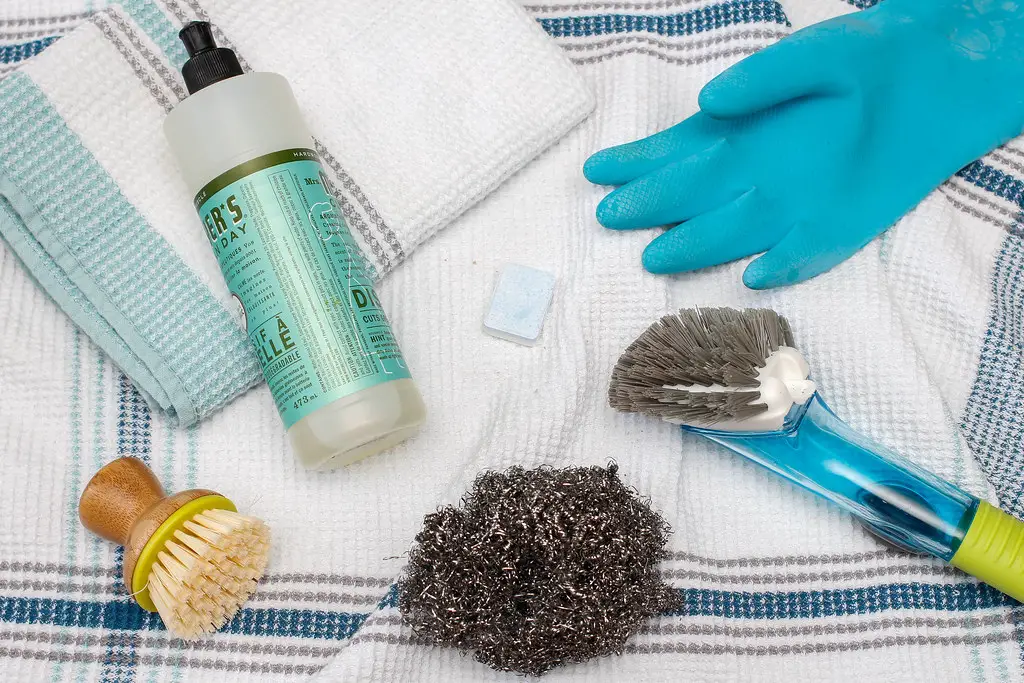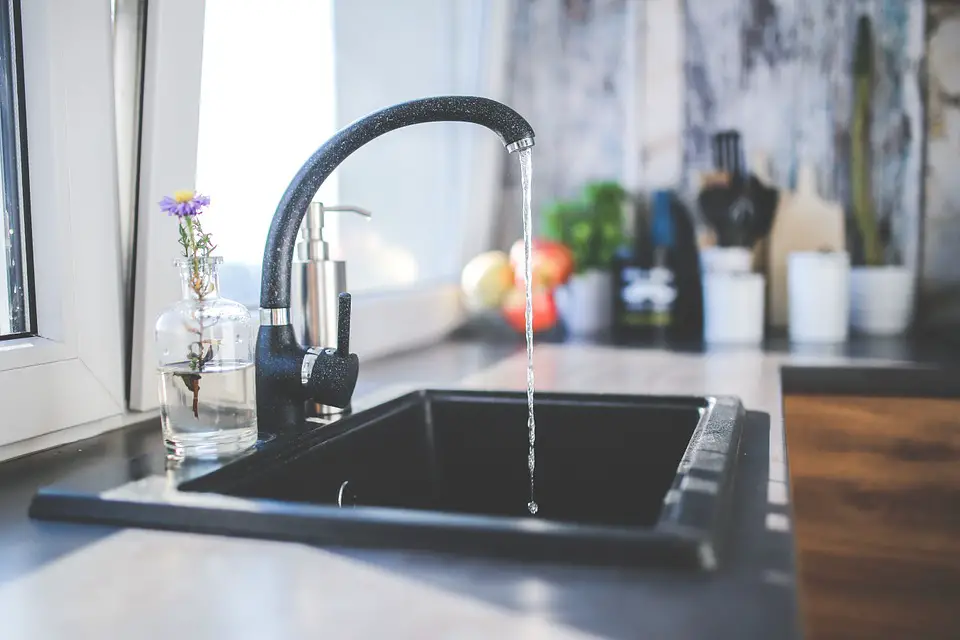Black composite granite sinks are fascinating furniture and designed with high quality in mind, lending a classy, elegant ambiance to any home kitchen.
The combination of quartz dust and acrylic resins explains their outstanding features and gorgeous look.
However, periodical cleaning is still crucial for keeping them in the best condition despite the dark color and durable material.
How to clean a black composite sink? The process consists of 5 steps.
- Prepare ingredients
- Prepare your sink
- Sprinkle baking soda
- Use vinegar
- Apply mineral oil
Aside from detailed instructions on cleaning your high-grade furniture and helpful maintenance hacks, we have also referred to some common mistakes to avoid during the process.
Let’s get right into the details!
How To Clean A Black Composite Sink?
With incredibly handy, obtainable cleaning elements on hand, you can complete the task in a short time without leaving a mess.
Prepare Ingredients
The necessary ingredients for the cleaning solution include vinegar, mineral oils, and baking soda.
Baking soda proves to be a safe ingredient to remove any dirty spot from acrylic resin surfaces softly and effortlessly.
Another popular element for protecting and maintaining luster and shine is mineral oil.
A granite surface is extremely sensitive and prone to damage caused by harsh ingredients or cleaners.
But don’t worry! Baking soda and vinegar are gentle, safe homemade solutions that pose zero harm.
Concerning deep cleaning, simply apply a thick coat of this combination and leave it to stay for a few hours. Also, you’ll need a bristle, soft-fabric rag, or brush to rub the surface.
Things like steel wool cleansers or wire brushes should never get in the way. These products will leave scratches and make the item less appealing.
Prepare Your Sink
You use your sink to wash various items and utensils, like food or dishes. So before starting, remove everything around and inside it, including cleaning stuff, food items, and utensils.
Ensure the inner and outer area is thoroughly empty and free of debris before getting down to the below steps.
Sprinkle Baking Soda
Next, it’s time to work with discoloration and stained areas, which are common with black composite sinks. And the go-to solution here is baking soda.
Sprinkle the element over the affected spots. This pro mild agent will help get rid of these stains quickly.
It’s safe and effective simultaneously, particularly for granite composite cabinet furniture.
Use Vinegar
Many people are not into using vinegar. If that’s your case, you can mix some water with it (1:1 ratio) and fill the mixture into a sprayer.
Then, spray the mixture over the areas where you’ve applied baking soda. Another possible method is to utilize a soft-bristle sponge or brush.
Gently scrub the solution into stained spots. Notably, this mixture can deal with regions where a liquid dries and produces stubborn stains extremely well.
Also, regions surrounding the drain will call for such an effective solution. All you need to do is scrub gradually and gently.
After that, rinse the mixture off the surface using warm water. Ensure to rinse constantly and properly until there’s no residue left.
Then, dry the sink with a soft fabric or some paper towels. The entire space should be thoroughly dry now.
Apply Mineral Oil
This final step is the savior that breathes the gloss and shines back on your furniture: apply mineral oil. You can buy the element from a nearby department shop.
Simply apply one tbsp of mineral oil, then gently buff it deep into the entire surface using a soft cloth or fabric. If you find the amount a bit less, add more later.
Ensure the fabric can hold oil evenly. You shouldn’t see a thick coat over the finish.
What to Avoid When Cleaning a Black Composite Sink?

You can accidentally damage your beautiful black kitchenette furniture by using inappropriate cleaning products.
That’s why we’re about to discuss the wrong cleaner or scrubber that you should never opt for if you don’t want to ruin the high-grade sink permanently.
Abrasive Materials
Though steel wool and Brillo pads are excellent assistants in washing numerous kinds of sinks, they never apply to black composite ones.
It’s advisable to choose much milder products for this task. Abrasive and rough scrubbers can hurt the glossy granite surface and leave many tiny, ugly scratches.
Harsh Chemicals
Composite sinks’ ability to handle dropped crockery and pans (or even a gunshot’s power) doesn’t mean they’re adept at surviving chemicals.
Too rough chemicals could cause discoloration and induce your furniture to lose its stunning appeal – chemicals to steer clear of include sulphuric and hydrochloric acid, sodium hydroxide, and ammonia.
Limescale Removers
The black color shows stubborn water spots more vividly than other colors, causing more people to utilize limescale removers to remove the hard mineral deposits.
However, those products are super abrasive and immediately damage the glossy finish.
Plus, they’re pretty low or high in pH, which could ruin the even granite surface and leave noticeable discolored marks.
Heat
Though pro-quality composite sinks come with outstanding heat resistance, the best idea is to avoid exposing them to heat as much as possible.
Also, we recommend against putting exceedingly hot pans and pots on a sensitive surface. If you’re unsure about your model’s heat resistance, seek help from your manufacturer.
Some Helpful Tips
- For typical food stains, a nylon scrub brush, clean water, and dish soap are perfect combinations for cleaning purposes.
- Hard water deposits or limescale staining are an alarming problem for dark-colored furniture as they become super evident. The best solution to remove these particles is diluted vinegar.
The point is that you don’t apply it straight on the surface but a mixture of vinegar and water (1:1 ratio).
- Check the model’s manual if you’re unsure about a particular agent’s safety. And if there’s no added manual, call its manufacturer.
The fastest way is to use the Internet. A simple search on Google will give you a lot of information about this.
Usually, manufacturers will provide you with proper recommendations on what chemicals and cleaners are best for the model without posing any damage.
FAQs
We’ve solved today’s topical question. Now is the time to walk through a few relevant ones that you’ll likely wonder about during the process.
What Is The Best Way to Clean A Black Sink?
Using microfiber or soft cloths (for example, E-cloth) is the best method. For tricky areas, a toothbrush or nylon scratchpad will work.
As said, you’d better apply a mixture of white vinegar and water (1:1 ratio) to get rid of limescale deposits.
After that, remember to rinse it thoroughly and avoid letting the vinegar touch the composite surface for too long.
Are Black Kitchen Sinks Hard To Keep Clean?
Whether it’s arduous to keep black sinks clean or not depends on the model’s material.
While black metal is prone to hard water and black porcelain may show smudges, black granite receives a lot of positive feedback.
How to Care for a Granite Composite Sink Ongoing?
The beauty of these high-quality sinks is that they don’t require daily or yearly maintenance, which regular solid granite ones will need.
For everyday care, you just need to rinse the finish thoroughly after every use to prevent water deposits or food particles from hardening.
If your model has a dark color, raising concern about tough water spots, we suggest drying it after every use with a lint-free towel.
How to Clean Stubborn Stains from the Composite Kitchen Sink?
- Mix whiting powder and hydrogen to create a thick coat.
- Apply the mixture to the stained areas.
- Cover the troubleshot stains with plastic wrap and leave them there for about 1-2 days.
- Unwrap the applied coat and use a soft sponge or cloth to wipe it out.
- Rinse & dry the entire place with clean water until it gets spotlessly clean. Finally, dry the surface and surrounding area using a paper towel or soft cloth.
Can You Use Bleach In Black Sinks?
Yes, bleach is safe to use for dark-colored sinks. First, fill the inner space with hot water, then add chlorine bleach (one cup). Leave the mixture there for about one hour and no longer than that.
The chlorine will eliminate bacteria and germs that might lurk on the composite surface while dissolving sticky residue, grime, and dirt.
Conclusion
While dark-colored composite sinks are many homeowners’ go-to options, thanks to their top-notch durability and longevity, proper maintenance should never fall out of concern.
Though learning how to clean a black composite sink and washing it every day seems tedious, the shiny, eye-catching result is worth the energy.
Spend a bit of time and effort now, and you can save countless hours of fixing long-term issues in the future! Thank you for reading!



